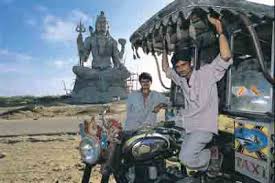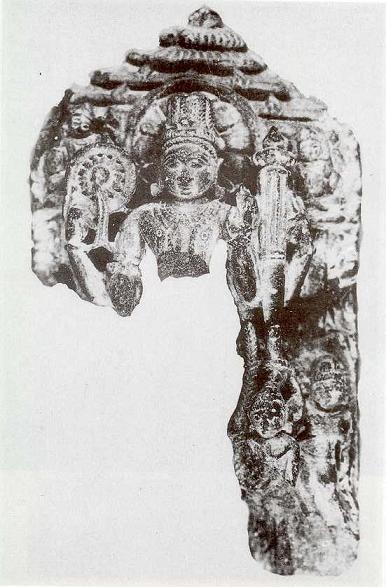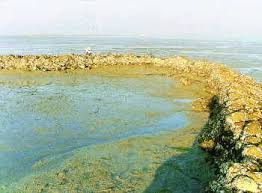









"The sea, which had been beating against the shores, suddenly broke the boundary that was imposed on it by nature. The sea rushed into the city. It coursed through the streets of the beautiful city. The sea covered up everything in the city. Arjuna saw the beautiful buildings becoming submerged one by one. He took a last look at the mansion of Krishna. In a matter of a few moments it was all over. The sea had now become as placid as a lake. There was no trace of the beautiful city, which had been the favorite haunt of all the Pandavas. Dwarka was just a name; just a memory." – Mausala Parva, Mahabharata.
Does this account from the ancient Indian epic have a true historical core? Did Lord Krishna, indeed the favourite Indian deity, walk the streets of ancient Dwarka? Did Krishna, considered the Lord of the universe by a billion Hindus, rule the Yaduvanshi clan thousands of years ago?
Using archaeological, scriptural, literary and astronomical data, scholars and scientists are coming round to the view that Krishna was definitely a historical character.
ARCHAEOLOGICAL EVIDENCE
The Rosetta stone, or the key, to the Krishna story is Dwarka. The strongest archaeological support comes from the structures discovered in the late 1980s under the seabed off the coast of modern Dwarka in Gujarat by a team of archaeologists and divers led by Dr S.R. Rao, one of India's most respected archaeologists. An emeritus scientist at the marine archaeology unit of the National Institute of Oceanography, Goa, Rao has excavated a large number of Harappan sites, including the port city of Lothal in Gujarat.
In his book The Lost City of Dwarka, published in 1999, he writes about his undersea finds: “The discovery is an important landmark in the history of India. It has set to rest the doubts expressed by historians about the historicity of Mahabharata and the very existence of Dwarka city.”
Conducting 12 expeditions during 1983-1990, Rao identified two underwater settlements, one near the present-day Dwarka and the other in the nearby island of Bet Dwarka. This tallies with the two Dwarkas mentioned in the epic. The underwater expeditions won Rao the first World Ship Trust Award for Individual Achievement.
Another important find by our divers was a seal that establishes the submerged township's connection with the Dwarka of the Mahabharata. The seal corroborates the reference made in the ancient text, the Harivamsa, that every citizen of Dwarka should carry such a seal for identification purposes. Krishna had ruled that none without the seal should enter it. A similar seal has been found onshore as well.
LITERARY EVIDENCE
The west coast of Gujarat was the traditional land of the Yadavs, or Yadus. According to the Bhagavad Puran, Krishna led the Yadavs thousands of kilometres west to establish Dwarka, so they could start a new life, safe from their many enemies in the Gangetic Valley.
The Mahabharata says, Dwarka was reclaimed from the sea. Rao’s divers discovered that the submerged city's walls were erected on a foundation of boulders, suggesting that land indeed was reclaimed from the sea.
One cannot separate Dwarka from Krishna. If the city existed, then it is true that Krishna ruled over it.
ASTRONOMICAL EVIDENCE
Dr Narhari Achar, professor of physics at the University of Memphis, Tennessee, has dated the Mahabharata war using astronomy and regular planetarium software. According to his research conducted in 2004-05, the titanic clash between the Pandavas and the Kauravas took place in 3067 BC. Using the same software, Dr Achar places the year of Krishna’s birth at 3112 BC.
Dr Manish Pandit, a nuclear medicine physician in the UK, after examining the astronomical, archaeological and linguistic evidence, agrees with Dr Achar’s conclusions. Dr Pandit, who is also a distinguished astrologer and has written several books on the subject, traced the route of Krishna’s journeys to shoot the documentary, “Krishna: History or Myth?”
Dr Pandit says there are more than 140 astronomy references in the Mahabharata. Simulations of the night sky have been combined with geographical descriptions to arrive at various dates. He says the chances of these references repeating are next to nothing.
According to historian S.M. Ali, the author of Geography of Puranas, “The geographical matter contained in the Mahabharata is immense. It is perhaps the only great work which deals with geographic details and not incidentally, as other works.”
WHOSE HISTORY?
Of course, none of the evidence is good enough for the ossified historians that lord over India’s academia, regurgitating the lies written by British colonial scholars, who were in reality Christian missionaries.
For the missionaries, destroying the historicity of Krishna was important if they had any chance of establishing their religion in India. Also, many European scholars were shocked to learn that Indian history pre-dated their world by thousands of years. By labelling as myth the Indian historical sources like the Vedas, Mahabharata, Upanishads, and especially the Puranas, which give exact chronologies of Indian kings including Krishna, the missionaries ensured that Indian history did not clash with their world view.
That tradition continues. Disregarding all new research, academics like Romilla Thapar, R.S. Sharma and Irfan Habib have consigned Krishna to mythology.
In his textbook for Class X, Sharma writes, “Although Lord Krishna plays an important role in the Mahabharata, the earliest inscriptions and sculpture pieces found in Mathura between 200 BC and 300 AD do not attest his presence.” What brilliant deduction. Going by Sharma’s logic, any fool can dig at a random site, and upon failing to discover an artefact, declare Krishna never existed. Sadly, millions of Indian school children are being taught such lies.
Thapar, in fact, says the Mahabharata is a glorified account of a skirmish between two “Aryan” tribes, with Krishna merely playing the role of an agent provocateur.
And what do they do when confronted with the new evidence? They withdraw into their parallel dystopian world and argue it is not clinching evidence. But, of course, they will accept as truth the myths of other religions.
Dr Rao says further digging and diving, in tandem with India’s vast treasure trove of historical facts will further corroborate key dates of our eventful and glorious past.
As the Upanishads say, pratnakirtim apavirnu – know thy past.
Jai Shri Krishna,hare Krishna!!!!
No comments:
Post a Comment